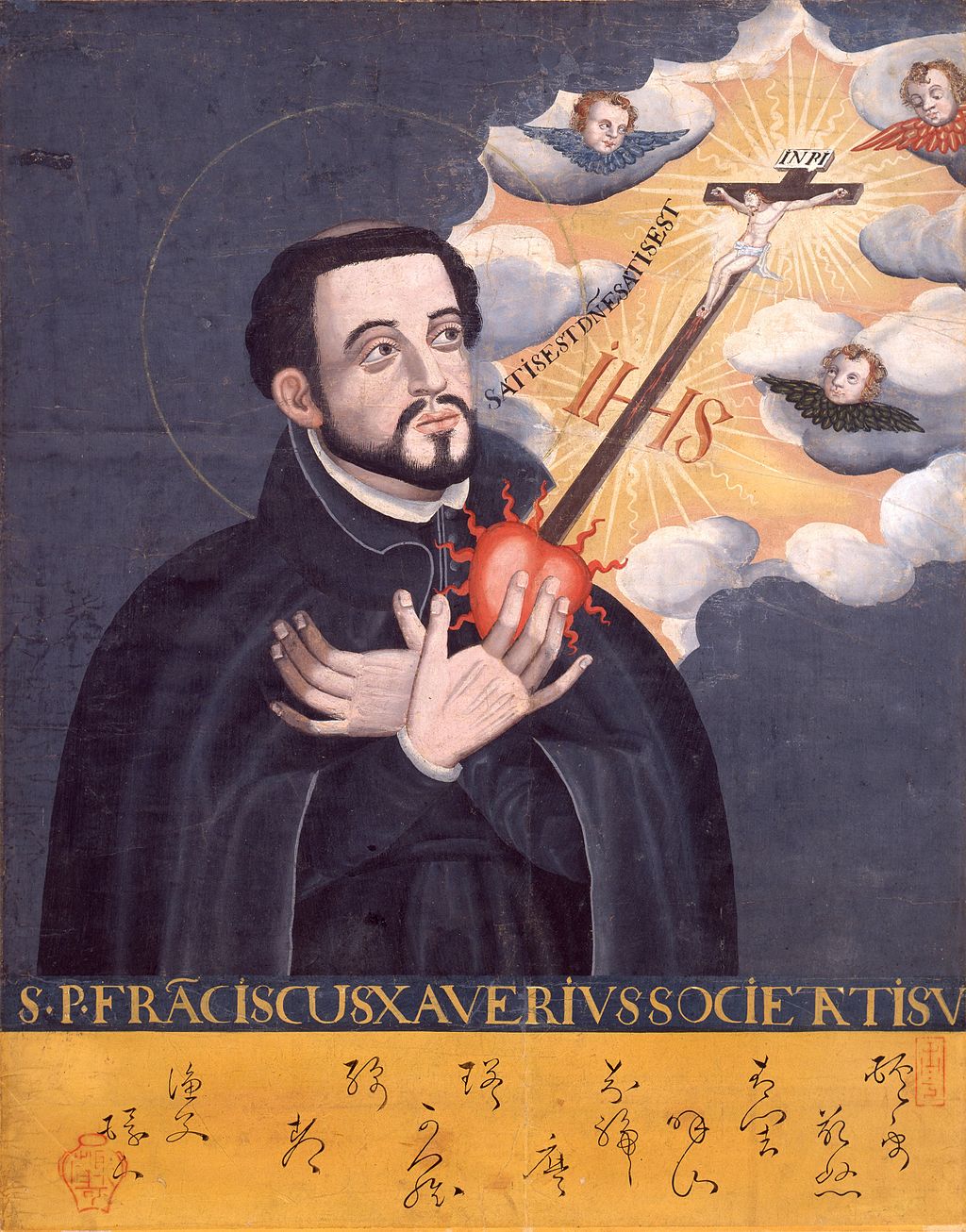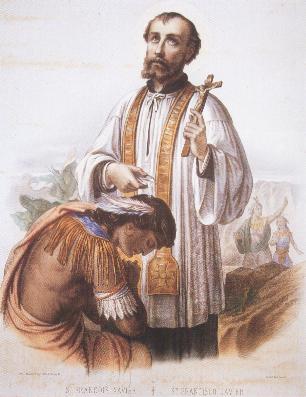拝啓ておふぃろ様ゑ
On Father Sohich IWASITA, or Francisco de Jasso y Azpilicueta

拝啓ておふぃろ様ゑ
On Father Sohich IWASITA, or Francisco de Jasso y Azpilicueta

拝啓ておふぃろ様ゑ
過日、神山復生病院を再訪しました。魚河岸で寿司もたべました。再訪にあわせて、重兼芳子 『闇をてらす足おと』春秋社、にも目を通しました。岩下神父の伝記よりも、作家の患者への聞き書きをとおした、伝記的再構成なので、なかなか、読ませるも のがありました(4年もの取材を重ねたそうです、ぼくのようないい加減なエスノグラファーには真似ができない集中力)。重兼の筆力のせいでしょう。岩下神 父の動画もみました。びっこの岩下の話は以前から知っていましたが、動画では、壮健そうに忙しく動いていました。これも収穫でしたね。
敬具 ふらんしすこ・さべりを

| Francis
Xavier, SJ (born Francisco de Jasso y Azpilicueta; Latin: Franciscus
Xaverius; Basque: Frantzisko Xabierkoa; French: François Xavier;
Spanish: Francisco Javier; Portuguese: Francisco Xavier; 7 April 1506 –
3 December 1552), venerated as Saint Francis Xavier, was a Spanish
Navarrese Catholic missionary and saint who was a co-founder of the
Society of Jesus. Born in the town of Xavier in the Kingdom of Navarre (present-day Spain), he was a companion of Ignatius of Loyola and one of the first seven Jesuits who took vows of poverty and chastity at Montmartre, Paris in 1534.[3] He led an extensive mission into Asia, mainly the Portuguese Empire in the East, and was influential in evangelisation work, most notably in early modern India. He was extensively involved in the missionary activity in Portuguese India. In 1546, Francis Xavier proposed the establishment of the Goan Inquisition in a letter addressed to the Portuguese King, John III.[4][5][6][7] While some sources claim that he actually asked for a special minister whose sole office would be to further Christianity in Goa,[8] others disagree with this assertion.[9] He was also the first Christian missionary to venture into Borneo, the Maluku Islands, and other areas. In those areas, struggling to learn the local languages and in the face of opposition, he had less success than he had enjoyed in India. Xavier was about to extend his mission to Ming China, when he died on Shangchuan Island. He was beatified by Pope Paul V on 25 October 1619 and canonized by Pope Gregory XV on 12 March 1622. In 1624, he was made co-patron of Navarre. Known as the "Apostle of the Indies", "Apostle of the Far East", "Apostle of China" and "Apostle of Japan", he is considered to be one of the greatest missionaries since Paul the Apostle.[10] In 1927, Pope Pius XI published the decree "Apostolicorum in Missionibus" naming Francis Xavier, along with Thérèse of Lisieux, co-patron of all foreign missions.[11] He is now co-patron saint of Navarre, with Fermin. The Day of Navarre in Navarre, Spain, marks the anniversary of Francis Xavier's death, on 3 December. |
|
| Francis
Xavier was born in the Castle of Xavier, in the Kingdom of Navarre, on
7 April 1506 into an influential noble family. He was the youngest son
of Don Juan de Jasso y Atondo, Lord of Idocín, president of the Royal
Council of the Kingdom of Navarre, and seneschal of the Castle of
Xavier (a doctor in law by the University of Bologna,[12] belonging to
a prosperous noble family of Saint-Jean-Pied-de-Port, later privy
counsellor and finance minister to King John III of Navarre)[13] and
Doña María de Azpilcueta y Aznárez, sole heiress to the Castle of
Xavier (related to the theologian and philosopher Martín de
Azpilcueta).[14] His brother Miguel de Jasso (later known as Miguel de
Javier) became Lord of Xavier and Idocín at the death of his parents (a
direct ancestor of the Counts of Javier). Basque[15] and Romance[16]
were his two mother tongues. In 1512, Ferdinand, King of Aragon and regent of Castile, invaded Navarre, initiating a war that lasted over 18 years. Three years later, Francis's father died when Francis was only nine years old. In 1516, Francis's brothers participated in a failed Navarrese-French attempt to expel the Spanish invaders from the kingdom. The Spanish Governor, Cardinal Cisneros, confiscated the family lands, demolished the outer wall, the gates, and two towers of the family castle, and filled in the moat. In addition, the height of the keep was reduced by half.[17] Only the family residence inside the castle was left. In 1522, one of Francis's brothers participated with 200 Navarrese nobles in dogged but failed resistance against the Castilian Count of Miranda in Amaiur, Baztan, the last Navarrese territorial position south of the Pyrenees. In 1525, Francis went to study in Paris at the Collège Sainte-Barbe, University of Paris, where he spent the next eleven years.[18] In the early days he acquired some reputation as an athlete[19] and a high-jumper.[20] In 1529, Francis shared lodgings with his friend Pierre Favre. A new student, Ignatius of Loyola, came to room with them.[21] At 38, Ignatius was much older than Pierre and Francis, who were both 23 at the time. Ignatius convinced Pierre to become a priest, but was unable to convince Francis, who had aspirations of worldly advancement. At first, Francis regarded the new lodger as a joke and was sarcastic about his efforts to convert students.[22] When Pierre left their lodgings to visit his family and Ignatius was alone with Francis, he was able to slowly break down Francis's resistance.[23] According to most biographies Ignatius is said to have posed the question: "What will it profit a man to gain the whole world, and lose his own soul?"[24] However, according to James Broderick such method is not characteristic of Ignatius and there is no evidence that he employed it at all.[22] In 1530, Francis received the degree of Master of Arts, and afterwards taught Aristotelian philosophy at Beauvais College, University of Paris.[22] |
|
| On
15 August 1534, seven students met in a crypt beneath the Church of
Saint Denis (now Saint Pierre de Montmartre), on the hill of
Montmartre, overlooking Paris. They were Francis, Ignatius of Loyola,
Alfonso Salmeron, Diego Laínez, Nicolás Bobadilla from Spain, Peter
Faber from Savoy, and Simão Rodrigues from Portugal. They made private
vows of poverty, chastity, and obedience to the Pope, and also vowed to
go to the Holy Land to convert infidels.[25][26] Francis began his
study of theology in 1534 and was ordained on 24 June 1537. In 1539, after long discussions, Ignatius drew up a formula for a new religious order, the Society of Jesus (the Jesuits).[23] Ignatius's plan for the order was approved by Pope Paul III in 1540.[27] In 1540, King John of Portugal had Pedro Mascarenhas, Portuguese ambassador to the Holy See, request Jesuit missionaries to spread the faith in his new possessions in India, where the king believed that Christian values were eroding among the Portuguese. After successive appeals to the Pope asking for missionaries for the East Indies under the Padroado agreement, John III was encouraged by Diogo de Gouveia, rector of the Collège Sainte-Barbe, to recruit the newly graduated students who had established the Society of Jesus.[28] Francisco Xavier taking leave of John III of Portugal for an expedition Ignatius promptly appointed Nicholas Bobadilla and Simão Rodrigues. At the last moment, however, Bobadilla became seriously ill. With some hesitance and uneasiness, Ignatius asked Francis to go in Bobadilla's place. Thus, Francis Xavier began his life as the first Jesuit missionary almost accidentally.[29][30][31] Leaving Rome on 15 March 1540, in the Ambassador's train,[32] Francis took with him a breviary, a catechism, and De Institutione bene vivendi by Croatian humanist Marko Marulić,[33] a Latin book that had become popular in the Counter-Reformation. According to a 1549 letter of F. Balthasar Gago from Goa, it was the only book that Francis read or studied.[34] Francis reached Lisbon in June 1540 and, four days after his arrival, he and Rodrigues were summoned to a private audience with the King and the Queen.[35] Francis Xavier devoted much of his life to missions in Asia, mainly in four centres: Malacca, Amboina and Ternate (in the Maluku Islands of Indonesia), Japan, and off-shore China. His growing information about new places indicated to him that he had to go to what he understood were centres of influence for the whole region. China loomed large from his days in India. Japan was particularly attractive because of its culture. For him, these areas were interconnected; they could not be evangelised separately.[36] |
|
| Francis
Xavier left Lisbon on 7 April 1541, his thirty-fifth birthday, along
with two other Jesuits and the new viceroy Martim Afonso de Sousa, on
board the Santiago.[37] As he departed, Francis was given a brief from
the pope appointing him apostolic nuncio to the East.[31] From August
until March 1542 he remained in Portuguese Mozambique, and arrived in
Goa, then capital of Portuguese India, on 6 May 1542, thirteen months
after leaving Lisbon. The Portuguese, following quickly on the great voyages of discovery, had established themselves at Goa thirty years earlier. Francis's primary mission, as ordered by King John III, was to restore Christianity among the Portuguese settlers. According to Teotonio R. DeSouza, recent critical accounts indicate that apart from the posted civil servants, "the great majority of those who were dispatched as 'discoverers' were the riff-raff of Portuguese society, picked up from Portuguese jails."[38] Nor did the soldiers, sailors, or merchants come to do missionary work, and Imperial policy permitted the outflow of disaffected nobility. Many of the arrivals formed liaisons with local women and adopted Indian culture. Missionaries often wrote against the "scandalous and undisciplined" behaviour of their fellow Christians.[39] The Christian population had churches, clergy, and a bishop, but there were few preachers and no priests beyond the walls of Goa. Xavier decided that he must begin by instructing the Portuguese themselves, and gave much of his time to the teaching of children. The first five months he spent in preaching and ministering to the sick in the hospitals.[40] After that, he walked through the streets ringing a bell to summon the children and servants to catechism.[41] He was invited to head Saint Paul's College, a pioneer seminary for the education of secular priests, which became the first Jesuit headquarters in Asia.[42] |
|
| Xavier
soon learned that along the Pearl Fishery Coast, which extends from
Cape Comorin on the southern tip of India to the island of Mannar, off
Ceylon (Sri Lanka), there was a Jāti of people called Paravas. Many of
them had been baptised ten years before, merely to please the
Portuguese who had helped them against the Moors, but remained
uninstructed in the faith. Accompanied by several native clerics from
the seminary at Goa, he set sail for Cape Comorin in October 1542. He
taught those who had already been baptised and preached to those who
weren't. His efforts with the high-caste Brahmins remained unavailing.
The Brahmin and Muslim authorities in Travancore opposed Xavier with
violence; time and again his hut was burned down over his head, and
once he saved his life only by hiding among the branches of a large
tree.[41] He devoted almost three years to the work of preaching to the people of southern India and Ceylon, converting many. He built nearly 40 churches along the coast, including St. Stephen's Church, Kombuthurai, mentioned in his letters dated 1544. During this time, he was able to visit the tomb of Thomas the Apostle in Mylapore (now part of Madras/Chennai then in Portuguese India).[31] He set his sights eastward in 1545 and planned a missionary journey to Makassar on the island of Celebes (today's Indonesia). As the first Jesuit in India, Francis had difficulty achieving much success in his missionary trips. His successors, such as de Nobili, Matteo Ricci, and Beschi, attempted to convert the noblemen first as a means to influence more people, while Francis had initially interacted most with the lower classes; (later though, in Japan, Francis changed tack by paying tribute to the Emperor and seeking an audience with him).[43] Voyages of Saint Francis Xavier  |
|
 Conversion of the Paravars by Francis Xavier in South India, in a 19th-century coloured lithograph. Conversion of the Paravars by Francis Xavier in South India, in a 19th-century coloured lithograph.Southeast Asia In the spring of 1545 Xavier started for Portuguese Malacca. He laboured there for the last months of that year. About January 1546, Xavier left Malacca for the Maluku Islands, where the Portuguese had some settlements. For a year and a half, he preached the Gospel there. He went first to Ambon Island, where he stayed until mid-June. He then visited the other Maluku Islands, including Ternate, Baranura, and Morotai.[40] Shortly after Easter 1547, he returned to Ambon Island; a few months later he returned to Malacca. |
|
| Japan Virgin Mary with Infant Jesus and Her Fifteen Mysteries. Bottom center: Ignatius of Loyola (left) and Francis Xavier (right) In Malacca in December 1547, Francis Xavier met a Japanese man named Anjirō.[40] Anjirō had heard of Francis in 1545 and had travelled from Kagoshima to Malacca to meet him. Having been charged with murder, Anjirō had fled Japan. He told Francis extensively about his former life, and the customs and culture of his homeland. Anjirō became the first Japanese Christian and adopted the name 'Paulo de Santa Fé'. He later helped Xavier as a mediator and interpreter for the mission to Japan that now seemed much more possible. In January 1548 Francis returned to Goa to attend to his responsibilities as superior of the mission there.[44] The next 15 months were occupied with various journeys and administrative measures. He left Goa on 15 April 1549, stopped at Malacca, and visited Canton. He was accompanied by Anjiro, two other Japanese men, Father Cosme de Torrès and Brother Juan Fernández. He had taken with him presents for the "King of Japan" since he was intending to introduce himself as the Apostolic Nuncio. Europeans had already come to Japan; the Portuguese had landed in 1543 on the island of Tanegashima, where they introduced matchlock firearms to Japan.[45] From Amboina, he wrote to his companions in Europe: "I asked a Portuguese merchant, ... who had been for many days in Anjirō's country of Japan, to give me ... some information on that land and its people from what he had seen and heard. ...All the Portuguese merchants coming from Japan tell me that if I go there I shall do great service for God our Lord, more than with the pagans of India, for they are a very reasonable people." (To His Companions Residing in Rome, From Cochin, 20 January 1548, no. 18, p. 178).[36] Francis Xavier reached Japan on 27 July 1549, with Anjiro and three other Jesuits, but he was not permitted to enter any port his ship arrived at until 15 August,[45] when he went ashore at Kagoshima, the principal port of Satsuma Province on the island of Kyūshū. As a representative of the Portuguese king, he was received in a friendly manner. Shimazu Takahisa (1514–1571), daimyō of Satsuma, gave a friendly reception to Francis on 29 September 1549, but in the following year he forbade the conversion of his subjects to Christianity under penalty of death; Christians in Kagoshima could not be given any catechism in the following years. The Portuguese missionary Pedro de Alcáçova would later write in 1554: In Cangoxima, the first place Father Master Francisco stopped at, there were a good number of Christians, although there was no one there to teach them; the shortage of labourers prevented the whole kingdom from becoming Christian. — Pacheco 1974, pp. 477–480 Francis was the first Jesuit to go to Japan as a missionary.[46] He brought with him paintings of the Madonna and the Madonna and Child. These paintings were used to help teach the Japanese about Christianity. There was a huge language barrier as Japanese was unlike other languages the missionaries had previously encountered. For a long time, Francis struggled to learn the language.[citation needed] He was hosted by Anjirō's family until October 1550.[24] From October to December 1550, he resided in Yamaguchi. Shortly before Christmas, he left for Kyoto but failed to meet with the Emperor. He returned to Yamaguchi in March 1551, where the daimyo of the province gave him permission to preach. Having learned that evangelical poverty did not have the appeal in Japan that it had in Europe and in India, he decided to change his approach. Hearing after a time that a Portuguese ship had arrived at a port in the province of Bungo in Kyushu and that the prince there would like to see him, Xavier now set out southward. The Jesuit, in a fine cassock, surplice, and stole, was attended by thirty gentlemen and as many servants, all in their best clothes. Five of them bore on cushions valuable articles, including a portrait of Our Lady and a pair of velvet slippers, these not gifts for the prince, but solemn offerings to Xavier, to impress the onlookers with his eminence. Handsomely dressed, with his companions acting as attendants, he presented himself before Oshindono, the ruler of Nagate, and as a representative of the great kingdom of Portugal, offered him letters and presents: a musical instrument, a watch, and other attractive objects which had been given him by the authorities in India for the emperor.[41] For forty-five years the Jesuits were the only missionaries in Asia, but the Franciscans also began proselytising in Asia as well. Christian missionaries were later forced into exile, along with their assistants. However, some were able to stay behind. Christianity was then kept underground so as to not be persecuted.[47] The Japanese people were not easily converted; many of the people were already Buddhist or Shinto. Francis tried to combat the disposition of some of the Japanese that a God who had created everything, including evil, could not be good. Despite Francis's different religion, he felt that they were good people, much like Europeans, and could be converted.[48][49][50] Xavier was welcomed by the Shingon monks since he used the word Dainichi for the Christian God; attempting to adapt the concept to local traditions. As Xavier learned more about the religious nuances of the word, he changed to Deusu[24] from the Latin and Portuguese Deus. The monks later realised that Xavier was preaching a rival religion and grew more resistant towards his attempts at conversion. With the passage of time, his sojourn in Japan could be considered somewhat fruitful as attested by congregations established in Hirado, Yamaguchi, and Bungo. Xavier worked for more than two years in Japan and saw his successor-Jesuits established. He then decided to return to India. Historians debate the exact path by which he returned, but from evidence attributed to the captain of his ship, he may have travelled through Tanegeshima and Minato, and avoided Kagoshima because of the hostility of the daimyo.[45] |
|
 Virgin Mary with Infant Jesus and Her Fifteen Mysteries. Bottom center: Ignatius of Loyola (left) and Francis Xavier (right) |
|
| China During his trip from Japan back to India, a tempest forced him to stop on an island near Guangzhou, Guangdong, China, where he met Diogo Pereira, a rich merchant and an old friend from Cochin. Pereira showed him a letter from Portuguese prisoners in Guangzhou, asking for a Portuguese ambassador to speak to the Chinese Emperor on their behalf. Later during the voyage, he stopped at Malacca on 27 December 1551 and was back in Goa by January 1552.[citation needed] On 17 April he set sail with Diogo Pereira on the Santa Cruz for China. He planned to introduce himself as Apostolic Nuncio and Pereira as the ambassador of the King of Portugal. But then he realized that he had forgotten his testimonial letters as an Apostolic Nuncio. Back in Malacca, he was confronted by the captain Álvaro de Ataíde da Gama who now had total control over the harbour. The captain refused to recognize his title of Nuncio, asked Pereira to resign from his title of ambassador, named a new crew for the ship, and demanded the gifts for the Chinese Emperor be left in Malacca.[citation needed] In late August 1552, the Santa Cruz reached the Chinese island of Shangchuan, 14 km away from the southern coast of mainland China, near Taishan, Guangdong, 200 km south-west of what later became Hong Kong. At this time, he was accompanied only by a Jesuit student, Álvaro Ferreira, a Chinese man called António, and a Malabar servant called Christopher. Around mid-November, he sent a letter saying that a man had agreed to take him to the mainland in exchange for a large sum of money. Having sent back Álvaro Ferreira, he remained alone with António. He died from a fever at Shangchuan, Taishan, China, on 3 December 1552, while he was waiting for a boat that would take him to mainland China.[51] |
|
| https://en.wikipedia.org/wiki/Francis_Xavier |
|
+++
Links
リンク
文献
その他の情報

